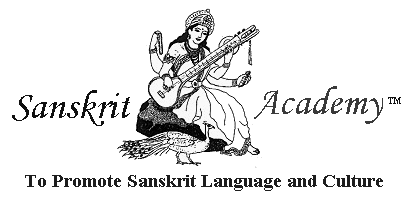
|
|

|
|
Letters in Sanskrit are believed to be loaded with mystic power that are yielded when pronounced correctly.
The sanskrit alphabet is well categorized and hence easy to learn. First, the alphabet is categorized into vowels and consonants as follows:
Vowels are pronounced by a smooth flow of air thro' the mouth. Sanskrit language has 13 vowels as shown below
| अ a | आ ā | इ i | ई ī | उ u | ऊ ū | ऋ ṛ |
| ए e | ऐ ai | ओ o | औ au | अं aṁ | अः aḥ |
| ॠ ṝ | ऌ ḷ |
Vowels can be classified further as simple and diphthong vowels. A simple vowels is also called a monophthong. The vowel has the same sound at the beginning and end. Simple vowels can be long or short. The difference is in the length of duration of pronunciation. Long vowels are pronounced twice as long as the short vowels.
| Short | Long | |
|---|---|---|
| Gutterals | अ a | आ ā |
| Palatals | इ i | ई ī |
| Labials | उ u | ऊ ū |
| Cerebrals | ऋ ṛ | ॠ ṝ |
| Dental | ऌ ḷ |
A diphthong is formed by the combination of two vowels in a single syllable, in which the sound begins as one vowel and glides smoothly towards the second. In Sanskrit all diphthongs are long vowels.
| Gutterals + Palatals | अ + इ (a + i) = ए e | आ + इ (ā + i) = ऐ ai |
|---|---|---|
| Gutterals + Labials | अ + उ (a + u) = ओ o | आ + उ (ā + u) = औ au |
Lastly there are the Anusvāra and the Visarga. Anusvāra is a nasal sound whose pronunciation varies based upon where it appears in the word. Visarga literally means sending forth. It is pronounced as if the air is expelled from the lungs. However, it's pronunciation varies based upon the preceding vowel.
| Anusvāra | अं aṁ |
|---|---|
| Visarga | अः aḥ |
Consonants are pronounced by stopping the air flow at the appropriate place. They can be pronounced only with the help of the vowels. So, traditionally when the alphabet is chanted, the consonants are combined with the vowel अ.
Consonants are grouped into mutes, semi-vowels and sibilants.
These consonants are pronounced by the complete closure of the various mouth organs. In fact, they are further categorized into several groups based on the mouth organ used for pronunciation.
| Surd - unaspirate (अघोष - अल्पप्राण) | Surd - aspirate (अघोष - महाप्राण ) | Sonant - unaspirate (घोषवत् - अल्पप्राण) | Sonant - aspirate (घोषवत् - महाप्राण ) | Nasal - unaspirate (अनुनासिका - अल्पप्राण) | ||
|---|---|---|---|---|---|---|
| Gutterals - कण्ठ्य | क ka | ख kha | ग ga | घ gha | ङ ṅa | |
| Palatals - तालव्य | च ca | छ cha | ज ja | झ jha | ञ ña | |
| Cerebrals - मूर्धन्य | ट ṭa | ठ ṭha | ड ḍa | ढ ḍha | ण ṇa | |
| Dentals - दन्त्य | त ta | थ tha | द da | ध dha | न na | |
| Labials - ओष्ठ्य | प pa | फ pha | ब ba | भ bha | म ma |
Like the vowels, these letters are pronounced by the smooth flow of air. However, like the consonants the sounds are made by stopping the air flow at the beginning of pronunciation. Hence, they are called "semi-vowels".
The semi-vowels have a special significance in Sanskrit. The Bija (seed) mantras are formed by these letters. Several Yoga breathing exercises use these letters as well.
There are five semi-vowels as shown below -
| Palatal | य ya | |
|---|---|---|
| Cerebral | र ra | |
| Dental | ल la | |
| Cerebral | ळ ḷa | |
| Labial | व va |
Sibilants make the hissing "s" sound. The sound is made by focussing the air intensely through a narrow channel. There are three sibilants in Sanskrit. The Aspirate is the sound made from the throat
| Palatal | श śa |
|---|---|
| Cerebral | ष ṣa |
| Dental | स sa |
| Gutteral | ह ha |
In Sanskrit, when vowels combine with consonants, the vowels are represented by special symbols. Vowels are generally represented by the same symbol irrespective of the consonant they combine with.
A combination of a consonant and a vowel yields a single syllable. Every syllable has one or two mātras (मात्र). Mātra is a unit of length in pronunciation. In other words, the length of a syllable is measured by a mātra. Short vowels and consonant combinations with short vowels have one mātra. Long vowels and consonant combinations with long vowels have two mātras.
Below is a list of all mātras with the consonant k (क्)

In Sanskrit there are special rules when blending two consonants. The rules are as follows: